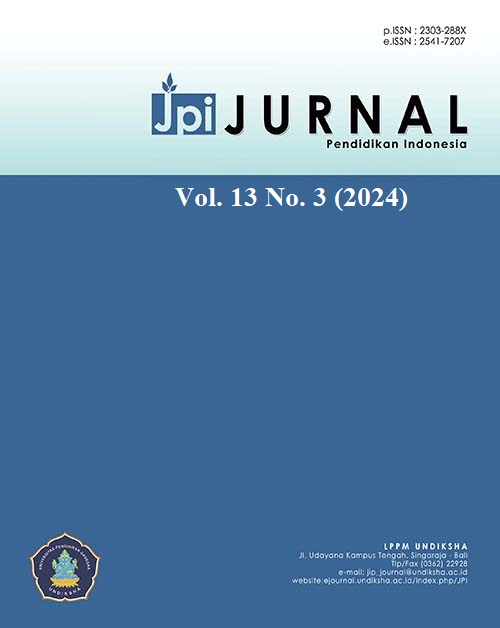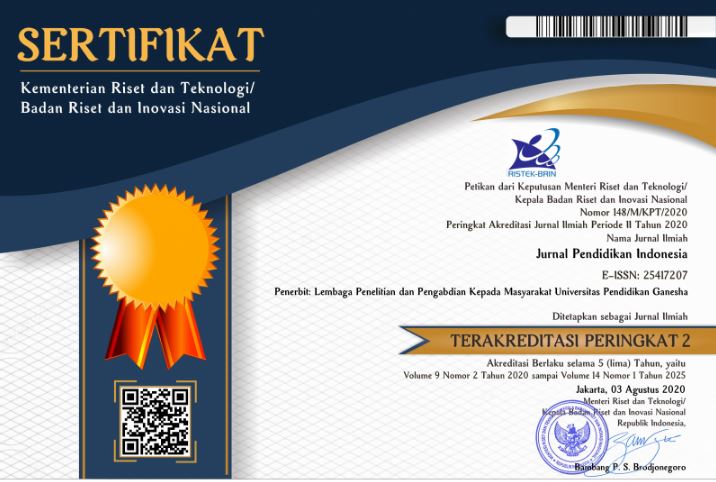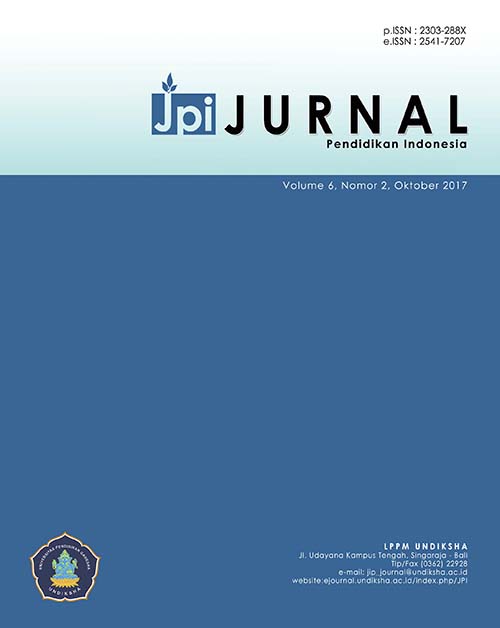Students' Readiness on Practical Learning in Mechanical Engineering Education: Post-Pandemic Survey
DOI:
https://doi.org/10.23887/jpiundiksha.v13i3.76249Keywords:
Practical Learning Readiness, Post-Pandemic Era, Vocational Education, Mechanical Engineering EducationAbstract
The post-pandemic era of COVID-19 still leaves crucial problems for vocational education (VE), including mechanical engineering education (MEE). Practical learning readiness (PLR), which includes the dimensions of readiness for supporting knowledge, physical and psychological conditions in students, is a fundamental problem that must be solved through systematic mapping. Therefore, this research aims to measure the level of readiness in these three dimensions. In addition, we also examine the differences between dimensions and indicators and test the determination in constructing the PLR to determine systematic problem-solving. The survey was conducted on 386 MEE students, but the final number was 339, considering that 47 of them did not have good data rationale level criteria. The results of the descriptive analysis confirmed that the psychological condition and supporting knowledge had a low level, while the physical condition had a high level. The results of the comparison test show that the three are generally not significantly different, although there are notes in several indicators. Although all dimensions contribute significantly to constructing PLR, psychological conditions contribute the highest. This indicates that low psychological conditions are the first step for VE to suffer. Furthermore, several notes related to the decrease in knowledge-supporting practice are also the second effort that MEE must make in boosting PLR in its students.
References
Ahmad, W. N. W., Idrus, A. A., Azman, M. N. A., & Kassymova, G. K. (2022). Correlates of mental health on online distance learning during COVID-19 among Malaysia vocational students. International Journal of Public Health Science, 11(1), 254–262. https://doi.org/10.11591/ijphs.v11i1.21105.
Alam, G. M., & Parvin, M. (2021). Can online higher education be an active agent for change? —comparison of academic success and job-readiness before and during COVID-19. Technological Forecasting and Social Change, 172(1), 1–13. https://doi.org/10.1016/j.techfore.2021.121008.
Alawajee, O. A., & Almutairi, H. A. (2022). Level of Readiness for In-Class Teaching Among Teachers of Students with Special Educational Needs: Post-COVID-19. Eurasian Journal of Educational Research, 2022(98). https://doi.org/10.14689/ejer.2022.98.01.
Astuti, M., Arifin, Z., Nurtanto, M., Mutohhari, F., & Warju, W. (2022). The maturity levels of the digital technology competence in vocational education. International Journal of Evaluation and Research in Education (IJERE), 11(2), 596–603. https://doi.org/10.11591/ijere.v11i2.22258.
Azizan, S. N., Lee, A. S. H., Crosling, G., Atherton, G., Arulanandam, B. V, Lee, C. E., & Rahim, R. B. A. (2022). Online Learning and COVID-19 in Higher Education: The Value of IT Models in Assessing Students’ Satisfaction. International Journal of Emerging Technologies in Learning, 17(3), 245–278. https://doi.org/10.3991/ijet.v17i03.24871.
Baharuddin, M. F., Masrek, M. N., & Shuhidan, S. M. (2020). Content validity of assessment instrument for innovative work behaviour of Malaysian school teachers. International Journal of Scientific and Technology Research, 9(4), 1940–1946. https://www.scopus.com/inward/record.uri?eid=2-s2.0-85083573758&partnerID=40&md5=0dfdf005baa2d27e61ad967227008407.
Billett, S. (2011). Vocational Education: Purposes, Traditions and Prospects. Springer. https://doi.org/10.1007/978-94-007-1954-5.
Clark, L., & Winch, C. (2007). Vocational Education : International Approaches, Developments and Systems. Routledge.
Dangi, M. R. M., & Saat, M. M. (2021). Interaction Effects of Situational Context on the Acceptance Behaviour and the Conscientiousness Trait towards Intention to Adopt: Educational Technology Experience in Tertiary Accounting Education. Educational Technology and Society, 24(3), 61–84. https://www.scopus.com/inward/record.uri?eid=2-s2.0-85110549985&partnerID=40&md5=8730113d7a03b1cb90d50403d6467d98.
Hadi, S., & Rabiman. (2019). The evaluation of industrial assisted classes program in vocational schools in Yogyakarta. IOP Conference Series: Materials Science and Engineering, 535(1), 1–8. https://doi.org/10.1088/1757-899X/535/1/012022.
Hair Jr, J. F., Ringle, C. M., Hult, G. T. M., Danks, N. P., Sarstedt, M., & Ray, S. (2021). Partial Least Squares Structural Equation Modeling (PLS-SEM) Using R. Springer Nature Switzerland AG.
Hews, R., McNamara, J., & Nay, Z. (2022). Prioritising lifeload over learning load: Understanding post-pandemic student engagement. Journal of University Teaching and Learning Practice, 19(2), 128–146. https://doi.org/10.53761/1.19.2.9.
Jaedun, A., Nurtanto, M., Mutohhari, F., Majid, N. W. A., & Kurdi, M. S. (2022). Mediating role of teachers’ self-efficacy and psychological capital in determining success during learning transition periods in vocational education. Journal of Education and E-Learning Research, 9(3), 207–215. https://doi.org/10.20448/jeelr.v9i3.4193.
Johnston, S. (1992). Images: A way of understanding the practical knowledge of student teachers. Teaching and Teacher Education, 8(2), 123–136. https://doi.org/10.1016/0742-051X(92)90003-L.
Karim, R. A., & Mustapha, R. (2022). TVET Student’s Perception on Digital Mind Map to Stimulate Learning of Technical Skills in Malaysia. Journal of Technical Education and Training, 14(1), 1–13. https://doi.org/10.30880/jtet.2022.14.01.001.
Ke, G. N., Grajfoner, D., Wong, R. M. M., Carter, S., Khairudin, R., Lau, W. Y., Kamal, K. A., & Lee, S. C. (2022). Building the Positive Emotion-Resilience-Coping Efficacy Model for COVID-19 Pandemic. Frontiers in Psychology, 13(1), 1–14. https://doi.org/10.3389/fpsyg.2022.764811.
Kurniawan, R., Jaedun, A., Mutohhari, F., & Kusuma, W. M. (2021). The Absorption of Vocational Education Graduates in The Automotive Sector in The Industrial World. Journal of Education Technology, 5(3). https://doi.org/10.23887/jet.v5i3.35365.
Leong, C. M., Goh, C. F., Ismail, F., Tan, O. K., & Ong, C. H. (2020). E-learning satisfaction: Investigating gender differences. International Journal of Electronic Commerce Studies, 12(1), 1–28. https://doi.org/10.7903/IJECS.1774.
Mardapi, D. (2012). Pengukuran, Penilaian, dan Evaluasi Pendidikan. Mitra Cendekia Press.
Mohamad, B., Abbas Adamu, A., & Akanmu, M. D. (2022). Structural model for the antecedents and consequences of internal crisis communication (ICC) in Malaysia oil and gas high risk industry. SAGE Open, 12(1), 1–13. https://doi.org/10.1177/21582440221079887.
Muktiarni, M., Ana, A., Barliana, M. S., Saleh, I., Mulyadi, Y., Salira, A. B., Sari, A. R., Masek, A. Bin, Paimin, A. N. B., Halim, F. B. A., & Muda, W. H. N. B. W. (2022). Readiness for online learning during covid-19 pandemic in the vocational education. Journal of Engineering Education Transformations, 35(Special Issue 2), 81–85.
Mutohhari, F., Sudira, P., & Nurtanto, M. (2021). Automotive engineering drawing learning: Effective online learning using autocad application. Journal of Education Technology, 5(2), 214–219. https://doi.org/10.23887/jet.v5i2.33197.
Mutohhari, F., Sutiman, S., Nurtanto, M., Kholifah, N., & Samsudin, A. (2021). Difficulties in implementing of 21st century skills competence in vocational education learning, Indonesia. International Journal of Evaluation and Research in Education (IJERE), 10(4), 1229–1236. http://ijere.iaescore.com/index.php/IJERE/article/view/22028.
Naidoo, P., & Cartwright, D. (2020). Where to from Here? Contemplating the Impact of COVID-19 on South African Students and Student Counseling Services in Higher Education. Journal of College Student Psychotherapy, 32(02), 1–15. https://doi.org/10.1080/87568225.2020.1842279.
Namubiru Ssentamu, P., Ng’ambi, D., Bagarukayo, E., Baguma, R., Mutambo Nabushawo, H., & Nalubowa, C. (2020). Enhancing student interactions in online learning: A case of using YouTube in a distance learning module in a higher education institution in Uganda. Higher Education Research, 5(4), 103–117. https://doi.org/10.11648/j.her.20200504.11.
Nguyen, H. H., Tuong, H. A., Hoang-Thi, M., & Van Nguyen, T. (2022). Factors influencing online learner performance during coronavirus disease pandemic: A case study in Vietnamese universities. European Journal of Educational Research, 11(3), 1509–1522. https://doi.org/10.12973/eu-jer.11.3.1509.
Putra, A. B. N. R., Heong, Y. M., Meidyanti, D. S., & Rahmawati, A. D. (2022). Hi World: The Virtual Book Learning Integrated Augmented Reality to Increase Knowledge of Covid-19 Prevention in The Learning Process Post-Pandemic Era. International Journal of Interactive Mobile Technologies, 16(6), 176–187. https://doi.org/10.3991/ijim.v16i06.29001.
Qazi, Z., Qazi, W., Raza, S. A., & Khan, K. A. (2021). Psychological distress among students of higher education due to e-learning crackup: moderating role of university support. Journal of Applied Research in Higher Education, 4(1), 1–14. https://doi.org/10.1108/JARHE-02-2021-0069.
Rabiman, R., Sudira, P., Sofyan, H., & Nurtanto, M. (2021). Practical learning media in subject maintenance of chassis and power (MCP) based online: Simple learning using videos on YouTube. International Journal of Interactive Mobile Technologies, 15(1), 130–145. https://doi.org/10.3991/ijim.v15i03.14943.
Rasmitadila, Aliyyah, R. R., Rachmadtullah, R., Samsudin, A., Syaodih, E., Nurtanto, M., & Tambunan, A. R. S. (2020). The perceptions of primary school teachers of online learning during the covid-19 pandemic period: A case study in Indonesia. Journal of Ethnic and Cultural Studies, 7(2), 90–109. https://doi.org/10.29333/ejecs/388.
Rea, L. M., & Parker, R. A. (2014). Designing and Conducting Survey Research: A Comprehensive Guide, 4th Edition. Jossey-Bass.
Reeves, J. J., Longhurst, C. A., San Miguel, S. J., Juarez, R., Behymer, J., Ramotar, K. M., Maysent, P., Scioscia, A. L., & Millen, M. (2022). Bringing student health and Well-Being onto a health system EHR: the benefits of integration in the COVID-19 era. Journal of American College Health, 70(7), 1968–1974. https://doi.org/10.1080/07448481.2020.1843468.
Rojewski, J. W. (2009). A Conceptual Framework for Technical and Vocational Education and Training BT - International Handbook of Education for the Changing World of Work: Bridging Academic and Vocational Learning (R. Maclean & D. Wilson (eds.); pp. 19–39). Springer Netherlands. https://doi.org/10.1007/978-1-4020-5281-1_2.
Salta, K., Paschalidou, K., Tsetseri, M., & Koulougliotis, D. (2021). Shift From a traditional to a distance learning environment during the COVID-19 pandemic: University students’ engagement and interactions. Science and Education, 12(01), 1–30. https://doi.org/10.1007/s11191-021-00234-x.
Santrock, J. W. (2007). Educational Psychology (2nd ed.). McGraw-Hill Ryerson.
Saripudin, S., Sumarto, S., Juanda, E. A., Abdullah, A. G., & Ana, A. (2020). Vocational school teachers’ perceptions of e-learning during covid-19. Journal of Engineering Education Transformations, 34(Special Issue), 7–13. https://doi.org/10.16920/JEET/2020/V34I0/157844.
Siow, M. L., Lockstone-Binney, L., Fraser, B., Cheung, C., Shin, J., Lam, R., Ramachandran, S., Novais, M. A., Bourkel, T., & Baum, T. (2021). Re-building students’ post-COVID-19 confidence in courses, curriculum and careers for tourism, hospitality, and events. Journal of Hospitality and Tourism Education, 33(4), 270–287. https://doi.org/10.1080/10963758.2021.1963973.
Sirisha, M., Mohebbanaaz, Rajiv, J., & Nalla, D. (2020). An efficient method to improve practical knowledge-technical lab report writing. Journal of Engineering Education Transformations, 33(Special Issue), 97–101. https://doi.org/10.16920/jeet/2020/v33i0/150074.
Skipor, S. I., & Vorobieva, A. E. (2021). Psychological characteristics of psychologists’ adaptation to online counseling during the covid-19 pandemic. Russian Psychological Journal, 18(1), 61–73. https://doi.org/10.21702/rpj.2021.1.5.
Spinazze, P. A., Kasteleyn, M. J., Aardoom, J. J., Car, J., & Chavannes, N. H. (2020). Cross-sectional analysis of university students’ health using a digitised health survey. International Journal of Environmental Research and Public Health, 17(9), 1–13. https://doi.org/10.3390/ijerph17093009.
Suherman, Y., Maryanti, R., & Juhanaini, J. (2021). Teaching science courses for gifted students in inclusive school. Journal of Engineering Science and Technology, 16(3), 2426–2438. https://www.scopus.com/inward/record.uri?eid=2-s2.0-85109565906&partnerID=40&md5=5356619d074d40d134bfe48d105ade2e.
Sukiman, Haningsih, S., & Rohmi, P. (2022). The pattern of hybrid learning to maintain learning effectiveness at the higher education level post-COVID-19 pandemic. European Journal of Educational Research, 11(1), 243–257. https://doi.org/10.12973/eu-jer.11.1.243.
Syauqi, K., Munadi, S., & Triyono, M. B. (2020). Students’ perceptions toward vocational education on online learning during the COVID-19 pandemic. International Journal of Evaluation and Research in Education, 9(4), 881–886. https://doi.org/10.11591/ijere.v9i4.20766.
Tang, S., & Siti Zuraidah, M. O. (2022). COVID-19 pandemic: Do learning motivation and learning self-efficacy exist among higher vocational college students? Journal of Education and E-Learning Research, 9(1), 38–44. https://doi.org/10.20448/jeelr.v9i1.3756.
Thaheem, S. K., Zainol Abidin, M. J., Mirza, Q., & Pathan, H. U. (2022). Online teaching benefits and challenges during pandemic COVID-19: a comparative study of Pakistan and Indonesia. Asian Education and Development Studies, 11(2), 311–323. https://doi.org/10.1108/AEDS-08-2020-0189.
Trilling, B., & Fadel, C. (2012). 21st Century Skills: Learning for Life in Our Times (1st ed.). Calif: John Wiley And Sons Inc.
Wagiran, W., Rahdiyanta, D., Wibowo, A. E., Sati, O. L., & Badu, M. R. (2020). Online learning of mechanical engineering subject in the Covid-19 era: Strategy, platform and media. Journal of Physics: Conference Series, 1700(1), 1–7. https://doi.org/10.1088/1742-6596/1700/1/012027.
Wagiran, W., Suharjana, S., Nurtanto, M., & Mutohhari, F. (2022). Determining the E-Learning Readiness of Higher Education Students: A Study During the COVID-19 Pandemic. Heliyon, 1–11. https://doi.org/10.1016/j.heliyon.2022.e11160.
Xue, J., Chen, J., Hu, R., Chen, C., Zheng, C., Su, Y., & Zhu, T. (2020). Twitter discussions and emotions about the COVID-19 pandemic: Machine learning approach. Journal of Medical Internet Research, 22(11), 1–16. https://doi.org/10.2196/20550.
Yawson, D. E., & Yamoah, F. A. (2020). Understanding satisfaction essentials of E-learning in higher education: A multi-generational cohort perspective. Heliyon, 6(11), 1–9. https://doi.org/10.1016/j.heliyon.2020.e05519.
Zainal Badri, S. K., & Wan Mohd Yunus, W. M. A. (2022). The relationship between academic vs. family/personal role conflict and Malaysian students’ psychological wellbeing during COVID-19 lockdown. Journal of Further and Higher Education, 46(1), 76–88. https://doi.org/10.1080/0309877X.2021.1884210.
Downloads
Published
Issue
Section
License
Copyright (c) 2024 Hermansah Suwondo Hermansah, Sutiman, Farid Mutohhari

This work is licensed under a Creative Commons Attribution-ShareAlike 4.0 International License.
Authors who publish with the Jurnal Pendidikan Indnesia agree to the following terms:
- Authors retain copyright and grant the journal the right of first publication with the work simultaneously licensed under a Creative Commons Attribution License (CC BY-SA 4.0) that allows others to share the work with an acknowledgment of the work's authorship and initial publication in this journal.
- Authors are able to enter into separate, additional contractual arrangements for the non-exclusive distribution of the journal's published version of the work (e.g., post it to an institutional repository or publish it in a book), with an acknowledgment of its initial publication in this journal.
- Authors are permitted and encouraged to post their work online (e.g., in institutional repositories or on their website) prior to and during the submission process, as it can lead to productive exchanges, as well as earlier and greater citation of published work. (See The Effect of Open Access)








